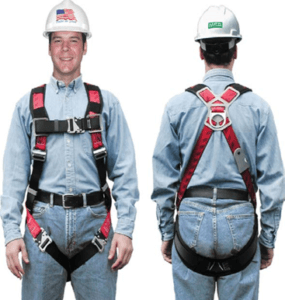According to OSHA, falls are the leading cause of death in the construction industry. To prevent falls, employees who are working above 6 feet are required to wear fall protection. Eliminating hazards is the first line of defense in fall protection.
Fall Protection Considerations
There are several fall protection considerations to account for when it comes to working above solid ground.
- You should make note of any holes over 2 inches. These should be covered to withstand 2 times the expected load and must be marked “hole” or “cover”. The covers must also be secured.
- Make note of the location and availability for safe anchorages. This will save you time once you’re in a lift you know where to anchor and you don’t have to spend time searching or moving looking for a safe anchor.

- Remember if you have to move a lift, you must be tied off safely. This will help protect you from any unforeseen circumstances where the lift might bounce and cause you to be bounced out of it.
Anchor Systems
Anchor systems provide a secure point of attachment for personal fall arrest systems. Anchors must be able to withstand at least 5,000 pounds.
They can be:
- A beam
- Column
- Rigid structure
They cannot be:
- Utility Pipes
- Electric Conduits
- Ductwork
- Guardrail Systems
- Hoists
- Unstable Points
Personal Fall Arrest Systems (PFAS)
PFAS can have several components to it. They can include self-retracting lifelines, a  rope grab (fall arrestor) and a shock absorbing lanyard.
rope grab (fall arrestor) and a shock absorbing lanyard.
All of these components must have a minimum tensile strength of 5,000 pounds. You should not attach more than one snap hook to a D-ring or tie two snap hooks together.
Make sure to inspect all of your fall protection equipment before you use it. You should look for:
- Cuts
- Abrasions
- Deformation
- Cracks
- Burn Damage
- Ultraviolet deterioration
If you see any of the above damage, tag and remove from service immediately. All equipment should be inspected periodically with documentation.
Safety should be everyone’s responsibility and number one priority while working. Having the correct fall equipment and safety training can protect workers from injuries. When workers are safe our customers save time and money.


